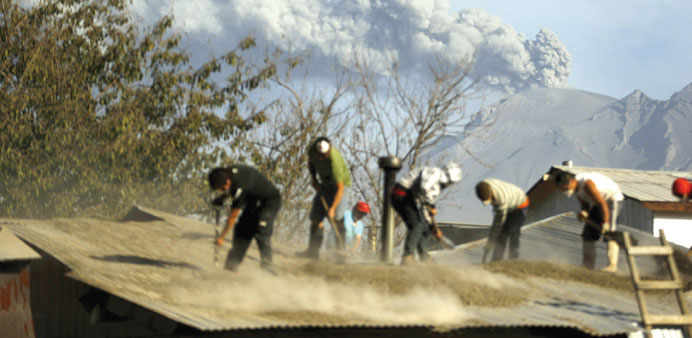Agencies/Santiago
Ash from the Chilean volcano Calbuco, which erupted without warning last week, reached as far as southern Brazil yesterday and prompted some airlines to cancel flights to the capitals of Chile, Argentina and Uruguay.
Calbuco, considered one of the most dangerous along Chile’s chain of around 2,000 volcanoes, erupted twice in 24 hours on Wednesday and Thursday, sending up a spectacular 17km cloud and coating nearby towns in a thick layer of grey ash.
Authorities have set up a 20km cordon around Calbuco, in the scenic Los Lagos region, around 1,000km south of the capital Santiago, evacuating more than 6,500 people in the area.
“The dangerous nature of volcanic activity like this, plus the volcano’s current instability that could lead to more intense activity in the short term, indicates we should maintain the perimeter,” Chile’s national office of emergency said in its latest report.
Authorities allowed people who had been evacuated to return briefly yesterday to check their houses and animals, and to pick up clothes and medication.
Some houses and schools located close to the volcano have collapsed under the weight of the ash.
The ash also presents a threat to air traffic, as particles in the atmosphere can cause problems for planes. With winds blowing the ash cloud northeast into Argentina, Argentine air traffic has been the worst affected so far.
Delta Air Lines, Air France, American Airlines, Air Canada and Qantas Airways have all suspended flights from and to the airports of Santiago, Buenos Aires and Montevideo as a precautionary measure.
But Chile’s LAN and Aerolineas Argentinas were operating flights as usual from those airports. “The situation is much better than yesterday,” said a spokesman for Argentina’s National Civil Aeronautic Administration.
“The airports (of Buenos Aires) are operating normally. The first ash cloud has already passed by and the second is on the move. American Airlines is not operating on their own accord, nor are Delta Air Lines, or United. They are evaluating the situation on a day-to-day basis.”
Some flights had also been cancelled in southern Brazil, in Rio Grande do Sul, broadcaster O Globo reported. Officials from the Brazilian aviation agency Infraero were not immediately available for comment.
The head of Chile’s mining and geological service said on Friday the volcanic process could last for weeks.
As some residents dug themselves out from beneath the thick layer of ash that blanketed the area, others who were evacuated from their homes gathered at the police barricade outside the town of La Ensenada, anxious to check on their houses and feed their pets.
On the other side of the security perimeter, the evacuation area was turned into a scattering of ghost towns blanketed with ash up to 1m thick, an AFP photographer said.
In La Ensenada, a town of 1,500 people that was the first to be evacuated, workers used heavy trucks to clear roads as a handful of residents ignored the evacuation order to shovel the ash and debris off their rooftops. The weight of the ash caused some roofs to collapse.
Experts cautioned that a third eruption could still follow. “We’re still in what is considered the crisis phase,” said Rodrigo Alvarez, head of the National Geology and Mines Service.
“It’s very difficult to say how explosive future eruptions will be, but we expect more activity similar to what happened” Wednesday and Thursday, said Carlos Cardona, a volcano expert at the service.
President Michelle Bachelet, who flew to the affected area Thursday, warned the situation remained “unpredictable.”
There have been no reports of injuries so far, but officials said the ash could be harmful for people, animals, crops and infrastructure.
Authorities handed out protective masks in affected towns in both Chile and Argentina.
The first eruption, which lasted about 90 minutes, spewed a giant mushroom cloud of ash into the sky, which turned hues of pink and yellow as the sun set over the area.
Seven hours later, the volcano shot red and orange bursts of lava into the sky, as bluish-white bolts of lightning sliced through the billowing ash cloud. Until minutes before the first blast, volcano monitoring systems had picked up nothing.
The 2,000m volcano had last erupted in 1961 and showed light activity in 1972, said the National Geology and Mines Service.
It is the second eruption in Chile since March 3, when the Villarrica volcano emitted a brief but fiery burst of ash and lava. Chile has about 90 active volcanoes.

Chileans clean an ash-covered roof of a house in Ensenada town.


